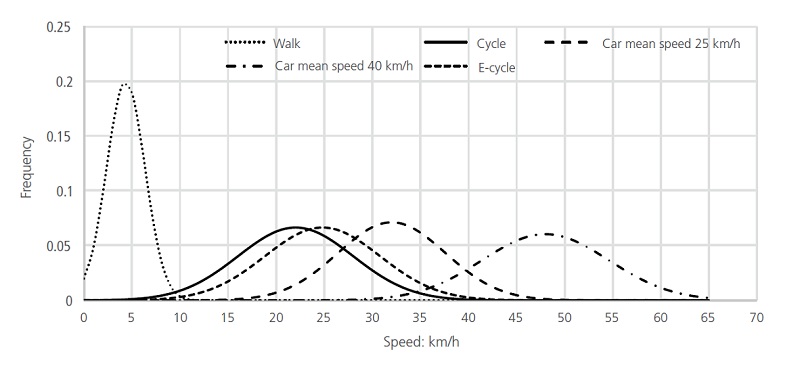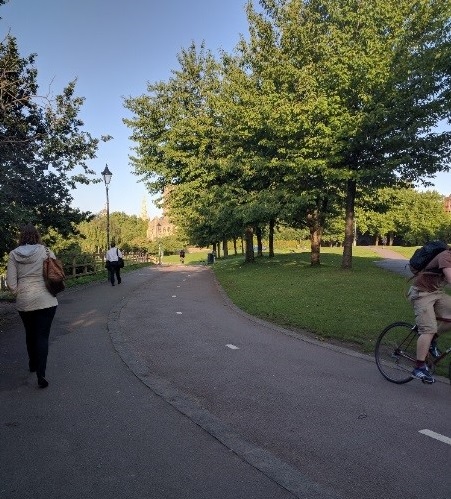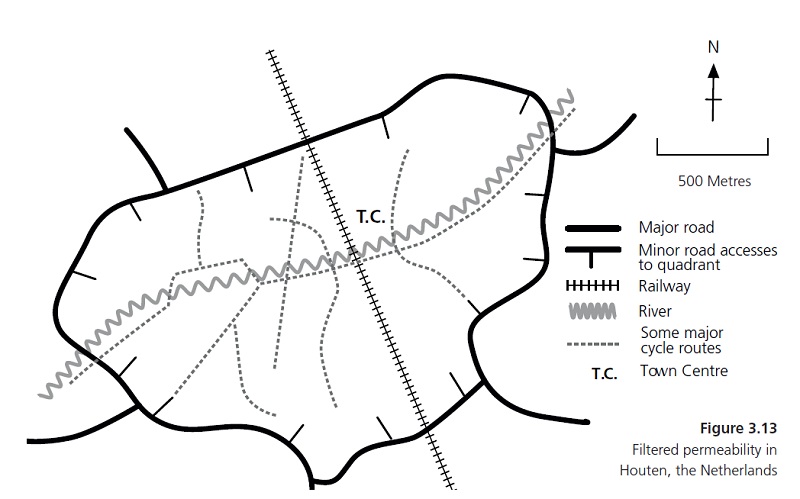Designing for cycle traffic
Designing and building appropriate infrastructure for cycle traffic is needed to increase levels of cycle use and reduce congestion in towns and cities. Professor John Parkin, UWE Bristol, discusses a new ICE publication advising how engineers can create conditions where anyone and everyone can cycle.
Contents |
[edit] Introduction
ICE has published 'Designing for cycle traffic', a book that explains the principles of good design, and exemplifies them through good international practice.
The book is timely because significant developments have taken place in recent years in both design guidance and practice. If we had no motorways, we’d have no motorway traffic, similarly, if we have no suitable cycleways, we’ll have no cycle traffic. We need the infrastructure to allow cycling to flourish.
The benefits of cycle traffic are that it’s much more efficient than motorised traffic and it creates safer and more liveable cities. Cycling also sustains local economic vibrancy, enables social inclusivity and minimises environmental damage.
[edit] Language
Language is important because it’s generally value-laden and affects the way we think.
Therefore, just as the Dutch, the Danes and the Germans do, the book talks about cycle traffic, and avoids the false dichotomy of ‘motor traffic and cyclists’.
Of course, the demands of traffic are not the only demands placed on the public realm, but the demands of cycle traffic are far less onerous than the demands of motor traffic.
[edit] Standards and ‘custom and practice’
Highway and traffic engineering are highly regulated by standards, but there’s also a good deal of ‘custom and practice’ that’s built up over the years. This custom and practice often results in extremely poor outcomes for cycle traffic.
The worst examples arguably are when weak attempts are made to reduce actual or perceived risk, but with no regard to the efficiency of movement still needed for cycle traffic.
Shared use footways are perhaps the classic example: they create problems of their own and have no regard for cycle design speed.
As well as outlining appropriate current standards, the book also considers potential future innovations
[edit] Principles
The most important principle any designer should recognise is that ‘the bicycle is a vehicle capable of speed’. This should be etched onto the desk of every designer because its implications are huge.
Being a vehicle, a cycle should be afforded the full usual traffic engineering specifications of control, warning and guidance everywhere along a route.
Every designer knows that the design speed flows through into every single aspect of the design including: horizontal and vertical curves, widths, and stopping sight distances.
[The design speed influences every aspect of design for cycle traffic.]
At just over 20 km/hr, the mean speed of cycle traffic is significantly higher than that of pedestrians at 4 km/hr.
Cycle traffic should, therefore, never be mixed with pedestrians. Exemptions to this basic rule might be at destinations, for example, central squares, or rural routes where pedestrian volumes are very low.
Motor traffic on roads with a 30 mph (50 km/hr) speed limit has a mean speed of typically 40 km/hr.
Again, this is too different from the speed of cycle traffic for comfortable mixing at anything other than very low motor traffic flows.
These speed differentials are a clear signal that cycle traffic should be provide with its own separated networks, as has been done for many years in The Netherlands.
[edit] Attractiveness and comfort
The cycle rider is exposed to the environment through which they travel.
This means that the environment has to be designed to be comfortable and attractive, and this can be achieved by careful alignment planning, and appropriate treatments.
[Routes need to be comfortable and attractive.]
[edit] Reducing motor traffic dominance and network design
A recognised significant reason limiting cycling uptake is the dominating presence of motor traffic, and motor traffic also has other negative impacts on the liveability of cities generally, such as land take, noise and pollution.
Lower speed limits (20 mph) may help reduce speed. To reduce volume, and create space for cycle traffic, re-engineering of area-wide traffic management schemes needs to take place.
Cycle routes themselves need to be part of a comprehensive network of routes.
[A hierarchy of routes needs to be developed.]
[edit] Cycling for all
By focusing on the design speed, a designer will be able to accommodate all types of cyclist. There are however very many different types of cycle, and they all need to be catered for.
Effective designs that allow anyone and everyone to cycle on all types of cycle will create efficient transport systems that support economic vibrancy, social activity, and environmental sustainability.
We’ll have achieved ‘cycling for all’, with all its benefits.
This article was originally published here by ICE on 4 Oct 2018. It was written by Professor John Parkin, UWE Bristol.
--The Institution of Civil Engineers
[edit] Related articles on Designing Buildings Wiki
Featured articles and news
The UK's Modern Industrial Strategy: A 10 year plan
Previous consultation criticism, current key elements and general support with some persisting reservations.
Building Safety Regulator reforms
New roles, new staff and a new fast track service pave the way for a single construction regulator.
Architectural Technologist CPDs and Communications
CIAT CPD… and how you can do it!
Cooling centres and cool spaces
Managing extreme heat in cities by directing the public to places for heat stress relief and water sources.
Winter gardens: A brief history and warm variations
Extending the season with glass in different forms and terms.
Restoring Great Yarmouth's Winter Gardens
Transforming one of the least sustainable constructions imaginable.
Construction Skills Mission Board launch sector drive
Newly formed government and industry collaboration set strategy for recruiting an additional 100,000 construction workers a year.
New Architects Code comes into effect in September 2025
ARB Architects Code of Conduct and Practice available with ongoing consultation regarding guidance.
Welsh Skills Body (Medr) launches ambitious plan
The new skills body brings together funding and regulation of tertiary education and research for the devolved nation.
Paul Gandy FCIOB announced as next CIOB President
Former Tilbury Douglas CEO takes helm.
UK Infrastructure: A 10 Year Strategy. In brief with reactions
With the National Infrastructure and Service Transformation Authority (NISTA).
Ebenezer Howard: inventor of the garden city. Book review.
The Grenfell Tower fire, eight years on
A time to pause and reflect as Dubai tower block fire reported just before anniversary.
Airtightness Topic Guide BSRIA TG 27/2025
Explaining the basics of airtightness, what it is, why it's important, when it's required and how it's carried out.
Construction contract awards hit lowest point of 2025
Plummeting for second consecutive month, intensifying concerns for housing and infrastructure goals.
Understanding Mental Health in the Built Environment 2025
Examining the state of mental health in construction, shedding light on levels of stress, anxiety and depression.


























